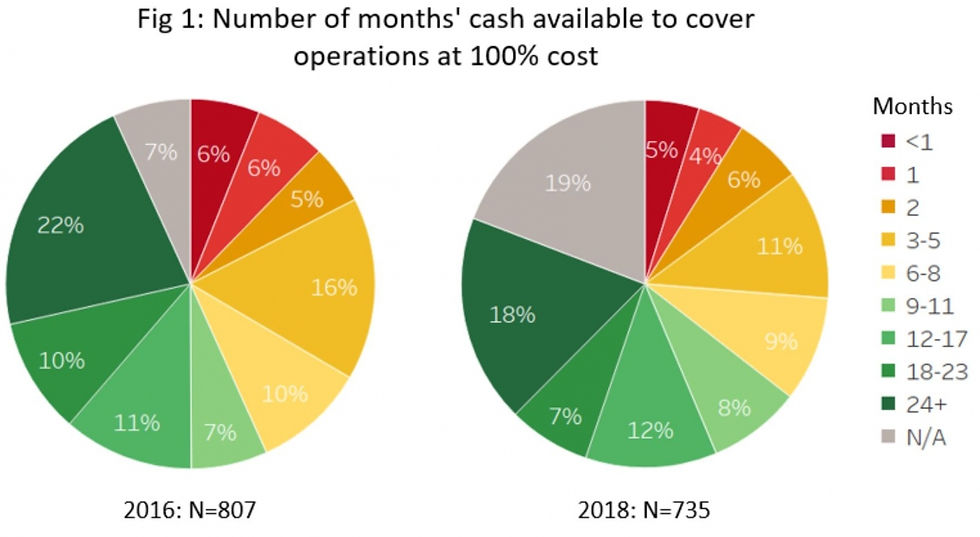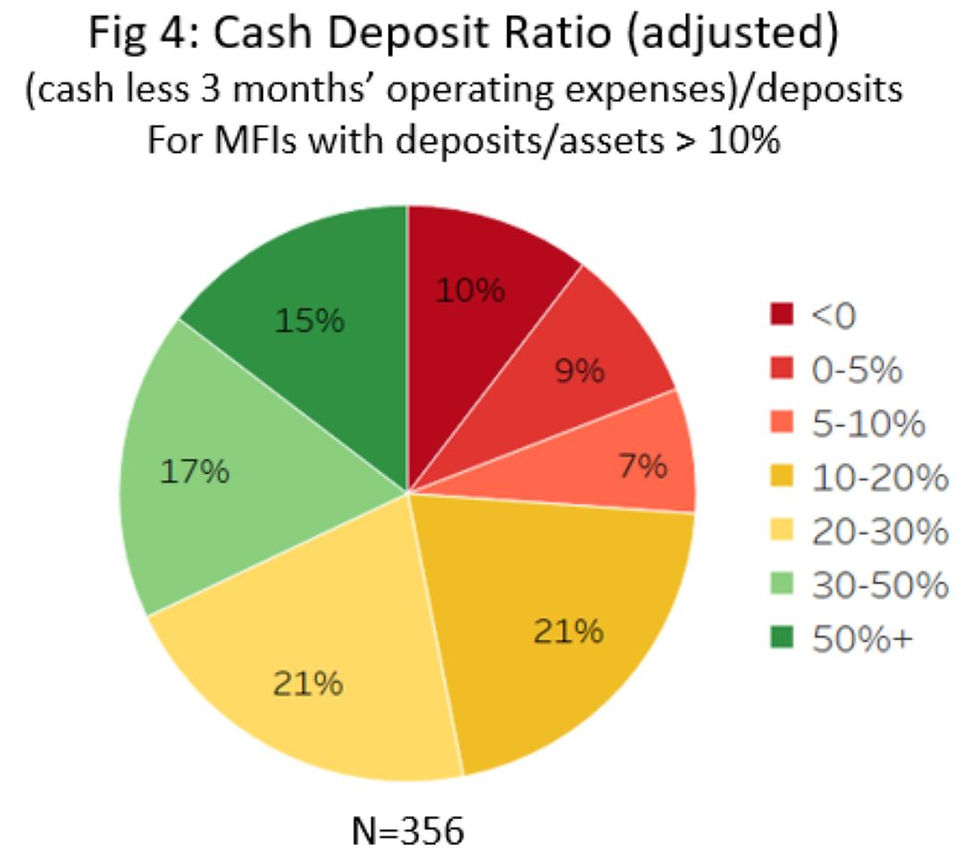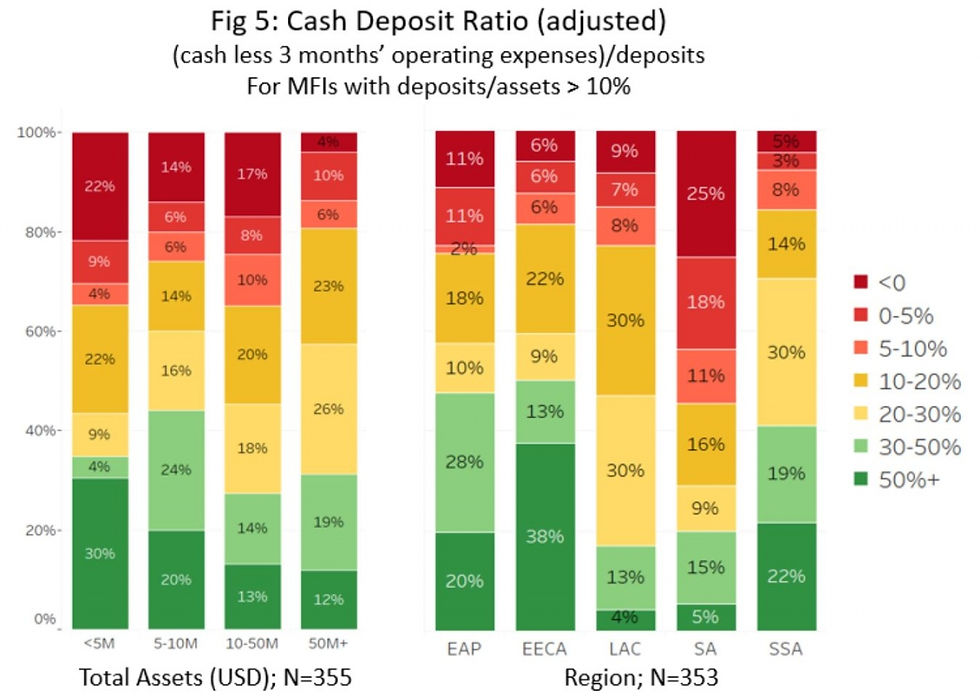How Long can Microfinance Institutions Last the Liquidity Crunch? An Analysis of the Data
- hdassy
- Apr 27, 2020
- 8 min read
Updated: May 16, 2024
Author: Daniel Rozas.
This piece was originally published on covid-finclusion.org
Liquidity has been foremost on the minds of just about everyone in the financial inclusion sector. Several essays on this site have delved into the topic. The first article in our liquidity series outlined three drivers for illiquidity: deposit withdrawals, operating costs, and maturing debt, and argues that maturing debt presents the greatest risk. But what does the data say? Here we will dig into that, and investigate just how severe the different elements of the liquidity crunch are to different categories of MFI around the world.
We don't have access to sector-wide data reflecting the situation right now. Nobody does. But we can get a good view of what may be happening from historical data collected by MIX Market over many years. Let's start with the most basic question. Assume an MFI is operating under complete shutdown, with no repayments, no new disbursements, and no other inflow or outflow of funds - it's operating entirely from cash reserves. How many months would it be able to survive before the money runs out?

Before we look at this - a few preliminaries. Figure 1 shows cash available to cover operations at 100% cost, for 2016 and 2018. You can see that, while MIX data pretty much ends in 2018, after 2016 it deteriorated significantly, with notable reporting gaps. But analysis of where those missing records come from don’t appear to reveal any particular bias in distribution regarding cash, deposits, operating expenses and other data discussed below. For this reason, all subsequent charts will rely on the more robust 2016 data. And realistically, both years are probably equally good at representing the state that the sector was in at the onset of the current crisis. From the 2016 series, we also remove records with missing data, so Figure 2 shows the cash available among all fully reporting MFIs in 2016:

The upshot is interesting. Nearly half (46%) of MFIs would have no trouble covering a full year's worth of operations and another 35% would be able to cover at least 6 months. The highest-risk situations, with cash reserves to cover no more than two months of operations, comprise 19% of institutions. Recall, moreover, that this assumes paying the full cost of normal operations - with all the commissions, bonuses, travel and other expenses that would be much lower during a shut-down. Under shut-down scenarios, we could reasonably expect operating expenses to be 20-30% lower than normal, without any salary cuts or staff reductions.
Of course this sort of analysis has limitations. While one might assume that debt repayments to investors might be temporarily suspended, an MFI with deposits cannot under any circumstances run down its cash reserves to anything close to zero; how else would it then be able to honour withdrawals from its savers? That analysis is a bit more complex, so for now, let's focus on credit-only institutions, and break them down in Figure 3 by total assets and also by region (East Asia Pacific and Sub-Saharan Africa have too few credit-only MFIs in the dataset and are removed).

Again, the colour key shows the number of months of cash available (still at 100% cost) - so green is the most resilient and red the most precarious. Most apparent from Figure 3 is that the smallest institutions have the smallest cash cushion; a third of them would not be able to survive under full shut-down for more than a month. Credit-only MFIs in Latin America look much the same. Meanwhile, among larger MFIs (US$10 million or more in assets), over half could fairly easily cope for nine months or longer. The situation looks even better in South Asia, where the proportion is about two-thirds. Again - these are credit-only MFIs, which don't have to worry about keeping cash to honour any deposit withdrawals. They really could go down close to zero and still survive.
But what about those that take deposits? These MFIs have to ensure they have enough cash to operate and still have cash on hand to honour withdrawals. To conduct this analysis, in Figure 4 we use an adjusted version of the Cash Deposit Ratio, first setting aside three months' worth of operating expenses and then examining how much cash would still remain to pay depositors. We also limit this to institutions for whom deposits are a significant funding source, including only those whose deposits are equal to at least 10% or more of total assets.

As with operating costs, the analysis here provides a degree of comfort. Figure 4 shows that more than half of institutions can cover 3 months of operating expenses, and still have enough cash to cover at least 20% of deposits. Our earlier analysis of deposits and liquidity pointed out that, absent a total run on the bank (triggered by fear of insolvency, a currency crisis, or similar), most deposit-taking MFIs' should have little difficulty allowing its savers to withdraw whatever they need for ongoing consumption. Assuming that implies an outflow of 5-10% of deposits, just over a quarter (26%) of MFIs would experience difficulty under that scenario.

A deeper dive in Figure 5 reveals some notable variations. On the left you see that, among the largest institutions, significantly fewer (19%) would be unable to honour deposit withdrawals above 10%. On the right it’s broken down by region. South Asia stands out as being especially high-risk, with over half (55%) unable to meet that threshold. Other regions show relatively modest variation (MENA is removed due to very few deposit-taking MFIs).
Finally, we come to the third and final driver of illiquidity: repayment of maturing debt. To model illiquidity risk, we make two adjustments. First, we set aside three months of operating expenses, and then, for deposit-taking MFIs only, we set aside additional cash to cover 10% deposit withdrawals. We then see how much debt the remaining cash can cover. Figure 6 examines this adjusted cash-to-debt ratio for credit-only and deposit-taking MFIs.

Here the picture is more concerning than with the other two drivers of illiquidity. Among credit-only MFIs on the left pie chart of Figure 6, a full 25% would not be able to cover any debt redemption, and only 19% would have the cash to cover redemptions of more than 30% of debt. The previous article in this liquidity series pointed out that on average over a quarter of debt outstanding is redeemed every six months. Were those debt repayments to be enforced, it would push a large majority of MFIs into a liquidity crisis.
The picture for deposit-taking MFIs on the right looks only slightly less serious. 26% would not be able to meet any debt redemptions and still have the minimum cash needed for operations and deposits. On the other hand, 48% have enough cash to cover redemption of at least 30% of debt and still be able to meet those operational and deposit needs. Note, however, that these are minimum cash requirements; in a time of crisis, a deposit-taking MFI ought to be maximising its liquidity, not aiming for a minimum threshold. So unless an MFI is really safely covered and has no risk of a liquidity crunch in even the direst of scenarios, it would be wise to limit debt repayments whenever possible.
Taken together, these analyses clearly show that liquidity is not a one-size-fits-all problem. Different institutions have different needs and face different risks. A significant number of them have quite a lot of cash on hand and could weather even the most severe scenarios without impacting their liquidity. But others will need substantial help - and in different ways.
Triaging the response
Like the patient in the emergency room, ensuring liquidity will require triage. Step one is to ensure that debt repayments and redemptions don’t create a liquidity crisis on their own. That halt doesn’t need to be a blanket moratorium; MFIs that have plenty of cash reserves may find it worthwhile to repay some of the excess debt, especially in an environment where demand for new loans is likely to be lower. But crucially, the decision to repay (or not repay) debt should be based on the needs of the MFI, and not those of the investors. Ira Lieberman and Paul DiLeo have an excellent proposal for an effective process to handle such a moratorium, and discussions like it are underway among investors.
Effective rescheduling of debt should meet the needs of most MFIs and should be sufficient to see them through the crisis itself. But not all. A significant number of MFIs have headed into this crisis with little cash on hand, some unable to meet more than a couple of months of operations or all but the most modest withdrawals of deposits. While help may be appropriate in some of those cases, it’s also legitimate to ask: why were their cash reserves so low in the first place, particularly if they have deposits? Perhaps it’s reasonable to provide modest emergency funding for a few months, but some will need to be evaluated more deeply, so that funds meant to address a crisis aren’t instead used to undo the earlier mistakes of poorly-run organisations. We should accept that those institutions may not survive the crisis.
What next?
In short, discussions pertaining to liquidity need to be highly focused on the issues the money is meant to address. For example, IFC has already announced large increases in emergency funding, which includes a substantial amount for financial institutions. But where will that money go? One useful area might be to support the liquidity-preservation efforts of others. A major risk in debt extension and restructuring is the cost of currency hedging - a problem for a large number of loans made in foreign currency. With hedging costs increasing in this volatile financial environment, it would be wrong to force an MFI to choose between absorbing a huge increase in the cost of the hedge or paying off a loan and thus eroding its much-needed liquidity. DFIs can - and should - step up to provide hedging subsidies through TCX (the primary hedge provider in the sector) so that the hedging costs of extended and rescheduled debt are kept stable.
There are also other areas where new money may be needed. The biggest, of course, are the households themselves, which have seen their incomes collapse and are suffering. For them, cash grants are absolutely appropriate and should be scaled up wherever possible. In some cases, MFIs may even be useful partners to channel such grants. But it is not the normal role of a financial institution to provide emergency loans to families that, at least now, are not able to repay them. In this environment, the focus must instead be on preserving the institutional capacity to honor deposit withdrawals and be ready to lend when appropriate: to SMEs providing food; to farmers seeking to plant; to healthcare clinics looking to buy critical supplies. But those needs must be clearly identified and MFIs that can make such loans should be given the additional funding to do so, if they need it.
Flooding financial institutions with cash just because there is a crisis at hand isn’t the answer - especially if much of that cash flows back out to debt redemptions of other investors.
A final point. All the analysis in this paper is based on data that is four years old. New, current data that reflects the market reality will be needed to make decisions about specific markets and institutions. We at e-MFP stand ready to support collection and sharing of such data to inform the sector. But even this analysis, we believe, already provides a useful template for thinking about the complex issues and trade-offs ahead.
About the Author:
Daniel Rozas is Senior Microfinance Expert at e-MFP





Comments